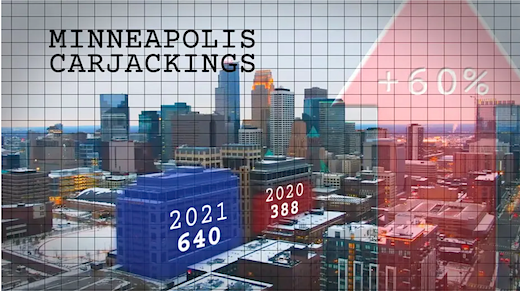The future of the City of Minneapolis is looking bleak, and that of the surrounding metropolitan area isn’t looking good either. But that isn’t the future that civic officials are concerned about. This local television story sheds light on why the Twin Cities are in the midst of a crime spree.
There are almost two carjackings a day in Minneapolis, a city of a little over 400,000:

As I’ve said before, I lived in the Twin Cities for more than forty years before, to the best of my recollection, I ever heard the word “carjacking” in a local context. The current crime wave is unprecedented.
[A]ccording to Minneapolis Police 75 percent of the suspects arrested were repeat offenders.
“To put that a different way in that same frame, 39 juveniles have three or more arrests. That’s 39 individuals with three or more arrests,” said Mayor Jacob Frey at a press conference in December.
How many times do the police need to catch them? Suburban police chiefs are skeptical that Hennepin County authorities have the will or the tools to stop the carjacking epidemic:
[T]he chiefs are skeptical that an old approach to homicide will not work with the new breed of carjackings, which they see as a form of “recreational violence.”
***
When asked about what happens to a juvenile in a violent carjacking, Thomasser said, “We’ll put them into a juvenile detention center. And then we’ll mostly find that they’re out shortly thereafter.In fact, our investigators now, when they start to see spikes in that crime type, carjackings, they’ll look to see who got out of jail, and they’ll use that as developing a possible suspect list as to whom we should start looking at for being responsible for those crimes.”
For example:
Just before Christmas, Isaiah Jamal Foster mugged an 81-year-old lady walking into Walgreens, leaving her with a concussion and broken pelvis.
Recreational violence.
A couple of days earlier, he was one of three suspects in a carjacking near Grand Avenue, with a two-year-old child in the car.
His mother recognized him on television, “100 percent sure,” she said – and called the police – who she said she doesn’t trust, because “she loves her son but didn’t raise him like that,” according to the criminal charges.
Even the kid’s mother understands that he belongs in jail.
Foster had just turned 18-years-old. Court records show he was already a veteran of the Hennepin County Juvenile System. His underage rap sheet includes robbery, auto theft, and assault.
Foster was facing four years in adult prison; instead, he got a six-month placement at a residential treatment center.
His alleged accomplice in the carjacking, a 17-year-old identified as A.J., has an even longer rap sheet: 14 felonies in Hennepin County, including two cases of aggravated robbery and auto theft.
Last June, he was recommended for adult prosecution. Instead: A.J. went to group homes, where he walked away twice and went AWOL from home monitoring seven times.
So most carjackings are committed by juveniles, not because they are put up to it by adults and not because they have a plan to make money, but because they like “recreational violence.” Minnesota merely sends these criminals to group homes from which they can easily walk away to commit more crimes.
The large majority of carjackings are committed by young people, minors and young adults, who are well known to the police who repeatedly refer them for prosecution. Why can’t we put them in prison and bring the carjacking “recreational violence” epidemic to a screeching halt?
Twin Cities prosecutors and police say they already know many of the repeat juvenile offenders in carjacking cases. Holding them accountable without jeopardizing their future is the challenge.
Without jeopardizing their future?! They forfeited their future when they chose a life of crime and “recreational violence.” These people have no future, as things stand, and putting them back on the street to commit more crimes only makes their future bleaker. Their best chance, and it is a slim one, is that they might find God while in prison.
The future that public officials should be concerned with is the future of a metropolitan area that is rapidly sliding downhill due to rampant crime. Also, the future of normal citizens who are carjacked, threatened with guns and knives, and knocked to the ground like the 81-year-old woman who suffered a concussion and a broken pelvis. At 81, she had a hell of a lot more useful life in front of her than did the worthless thug who assaulted her.
When civic authorities think their main obligation is to the criminal, not to the criminal’s victim, the result, predictably, is what we see in the Twin Cities.
Notice: All comments are subject to moderation. Our comments are intended to be a forum for civil discourse bearing on the subject under discussion. Commenters who stray beyond the bounds of civility or employ what we deem gratuitous vulgarity in a comment — including, but not limited to, “s***,” “f***,” “a*******,” or one of their many variants — will be banned without further notice in the sole discretion of the site moderator.